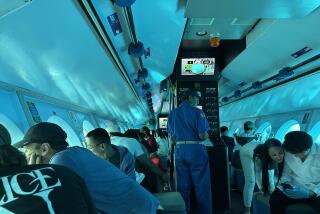Where Robots Go, Scientists Needn’t
- Share via
PROVIDENCE, R.I. — The ship with all the gadgets and underwater rovers was stationed in the middle of the Atlantic Ocean, but for the first time, the scientists directing the expedition were not aboard.
They sat in rooms thousands of miles away.
The scientists and technicians, at universities in Rhode Island, Washington state and New Hampshire, watched 42-inch plasma screens as unmanned submersibles poked around the hydrothermal vents of Lost City -- a forest of limestone chimneys spread across an area the size of two football fields.
Using headsets, the expedition’s leaders stationed at the University of Washington told engineers on the ship where to send the robotic vehicles and the high-definition video cameras, and what to explore next.
“We’re treated like the chief scientist on the ship that makes the decision about it. It’s just that we’re not there,” said the expedition’s co-leader, Deborah Kelley, a geology professor at the University of Washington in Seattle.
Supporters say the mission, which ended Aug. 1, has broad implications for future exploration of the oceans, which cover about 70% of Earth but remain mostly unexplored. For one, it shows ships can stay at sea for as many as eight months of the year, since the scientists no longer need to be aboard.
“No scientist will sit on [a ship] for that long, reading a book and eating popcorn for the whole time, no way,” said the other co-leader, Robert Ballard, who discovered the Titanic shipwreck in 1985 and is director of archeological oceanography program at the University of Rhode Island.
A combination of technology, conceived by Ballard, helped pull off the feat. The expedition used fiber-optic cables, satellite feeds, and a special, high-speed Internet connection to transmit images from the roving submersibles’ at Lost City to the three “control” rooms within 1.5 seconds.
The images were stunning, said Jeffrey Karson, a geology professor at Duke University. Karson, who explored Lost City in dives in 2000 and 2003, said the two remotely operated submersibles, one shining a bright light over a wide area and the other filming with a high definition camera, gave scientists a panoramic view of the vent field.
“It was more like we could see the whole building, instead of just a room,” Karson said.
Lost City is a series of hydrothermal vents located at a north-south underwater mountain chain called the Mid-Atlantic Ridge, which runs through the middle of the Atlantic Ocean. The site’s limestone chimneys, created by crystallization can reach 200 feet in height.
Hydrothermal vents were first discovered by Ballard in 1977 near the Galapagos Islands in the Pacific Ocean. Those fields, called black smokers because of the color of the fluids released, are located around underwater volcanoes. But Lost City, discovered five years ago and nowhere near any undersea volcanoes, showed that vents could be found elsewhere. So far, no similar vents have been found.
Life in this part of the ocean is sustained by the heat and gases emitted by the vents -- a process that scientists believe is similar to what happened on Earth in its earliest days. That’s one reason they have explored and mapped the site in such detail.
The underwater probes operated around the clock, to maximize data collection on the trip. The scientists in Seattle worked in six-hour shifts to keep a constant eye on the transmitted images. Meanwhile, the probes collected samples of the chimneys, the fluids and gases emitted and of the unique colonies of microscopic organisms that live around the vents. The samples will help scientists understand how Lost City works.
“It has to do with this kind of life, this novel kind of life as far as we know on this planet,” Karson said. “And it could be important in the history of life on this planet and perhaps on other planets.”
The trip was broadcast live four times a day at museums, science centers and aquariums, in schools, and at Boys and Girls Clubs nationwide. Sixteen students from Page Middle School in Madison Heights, Mich., gave up part of their summer break to watch and discuss the expedition through Ballard’s program called Immersion Presents.
Some came away with their imaginations aroused, said Dale Steen, director of technology for the Lamphere School District, which serves Madison Heights.
“A couple of parents on the side said, ‘You know what, my kid is so interested in underwater [robotic vehicles] that they’re building it with Legos,’ ” Steen said.
More to Read
Sign up for Essential California
The most important California stories and recommendations in your inbox every morning.
You may occasionally receive promotional content from the Los Angeles Times.













